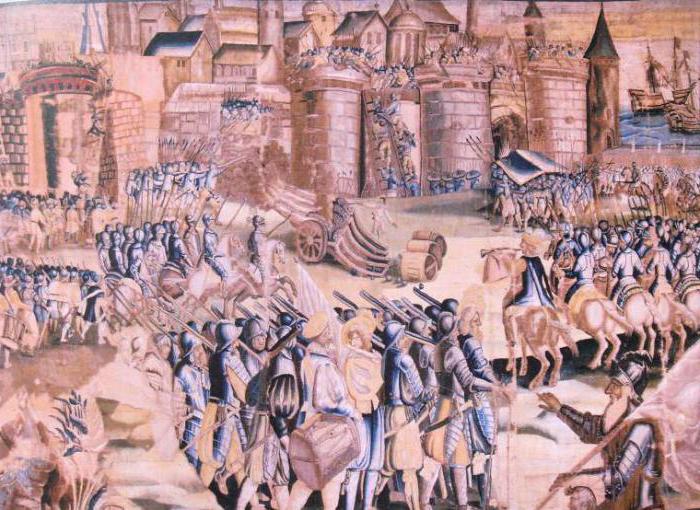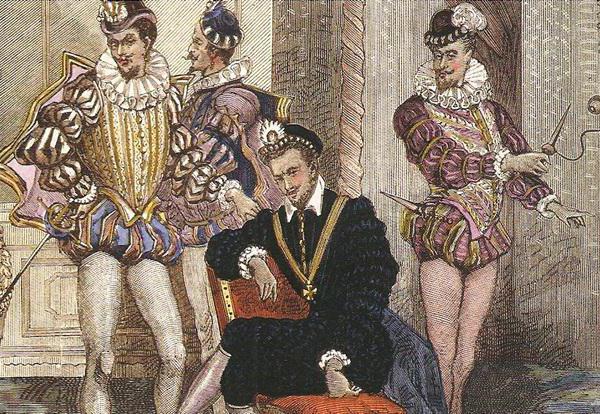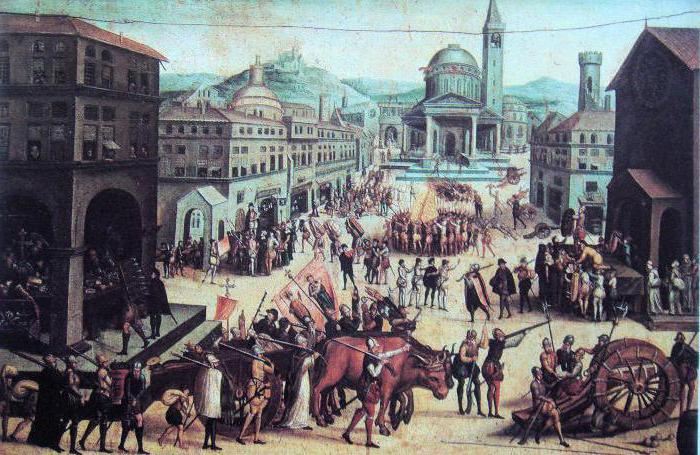Henry 3 of Valois - Duke of Anjou (until 1574), king of the Commonwealth (1573-1574), king of France (from 1574) and, finally, the last of the Valois dynasty. Historians evaluate this man in two ways. For a long time he was considered a life-burner, whose faithful companions were vices and shortcomings. However, later researchers began to say that Henry III was completely different - a wise and progressive ruler. The assassination of Henry 3 of Valois was as stupid as all religious wars. And now, first things first. Today we will not incline to this or that camp of historians, but only consider this, certainly, interesting person, from the point of view of facts.
Childhood
On September 19, 1551, a third son was born in the family of Henry II and his wife Catherine de Medici. He was called Edward-Alexander and was immediately awarded the title "Duke of Anjou." The chances of the guy becoming king were very illusory, because he had two older brothers. From young nails, Henry (so as not to be confused, we will call our hero that way), like the other children of the family, was sick a lot. From his brothers and sisters, he was distinguished by his love for outdoor activities - dancing and fencing. Perhaps due to physical activity, Henry grew up a strong guy and did not become a victim of tuberculosis, which took the lives of his brothers and sisters. Just imagine: out of ten children, only Henry and his younger sister Margarita survived Catherine de Medici.
Youth
In addition to dancing and fencing, Henry very much liked to read, actively studied Italian and rhetoric. He was much more active and elegant than his brothers, for which he quickly became a mother's favorite. She called him "my little eagle."
In 1560, Henry II accidentally died in a knightly tournament. His place on the throne was taken by the eldest son - Francis II. When the newly-made king died of diseases, he was replaced by the second son of Catherine - Charles IX. At the initial stage of his reign, the country was actually led by Catherine de Medici (as regent). At that time, she no longer hid that Karl was not so fond of her as Henry. Because of this, the relationship between the brothers did not work out in the best way.
In the period from 1564 to 1566, the hero of our story traveled around France along with the entire royal court. On a trip, he became friends with Heinrich of Navarre, his cousin.
First titles
In 1566, the 15-year-old Henry was entrusted with three duchies in the reign. A year later, when the religious war began, he was given the rank of lieutenant general and was appointed chief commander of the royal troops. Of course, more experienced military leaders helped the young man, but he always reserved the last word. Thanks to this, at the beginning of his military career, Henry earned a reputation as a wise commander. Largely thanks to the energy, intelligence and talent of the youth, the royal troops several times defeated the army of the Huguenots.
Despite military successes, Henry 3 of Valois did not like military affairs. Like his mother, he was a supporter of peaceful solutions to conflicts and preferred to engage in politics. Soon, Catherine insisted that the post of quartermaster was established for Henry, which in fact allowed him to share power with his brother and mother.
In 1750, when Catholics made peace with the Huguenots, Admiral Coligny, the leader of the Protestants, appeared on the council of Charles IX. He quickly managed to win over the king and convey to him the charm of the idea of renewing the confrontation with Spain. Due to Coligny's influence on Charles IX, Catherine and Henry lost their political weight for some time. The admiral became a mediator between the Protestant countries of Europe (especially England) and Catholic France. As a result of the policy of Coligny, France faced a choice: a war with Spain or another civil war with the Huguenots.
According to the calculations of military advisers, a new war with Spain will bring fiasco to France. And the resumption of religious differences was extremely undesirable for a country exhausted by coups. Therefore, if the first attempt to kill Coligny was conceived by Catherine and Henry, then they acted solely within the interests of the state. It is important to note that in those days, Machiavelli's ideas were popular in Europe. Catherine separated them and tried to raise children in the same spirit. It is possible that precisely such views were shown on Bartholomew’s night.
Bartholomew’s night and a broken heart
Two weeks before the terrible event, two weddings took place in the framework of strengthening relations between Protestants and Catholics. At the first of these, one of the Huguenot leaders - Prince Conde - was engaged to Mary of Kiev. The girl was brought up in the spirit of Protestantism, but for several years she was at the court of Charles IX. Henry passionately loved Mary, but his mother did not allow him to marry the girl. There were two reasons for this. Firstly, the family of Mary was not enough noble. And secondly, everyone knew that she should become the wife of Prince Conde. Submitting to the will of his mother and state interests, Henry 3 Valois drowned out the voice of his heart .

After the terrible Bartholomew’s night, a new religious war became inevitable. The Huguenots chose La Rochelle fortress in southern France as a stronghold. Henry III had to return to military affairs and arrive at the walls of the fortress in February 1573 at the head of the royal army. Attempts to siege and storm the fortress were futile. And at the beginning of summer, Henry had to leave from under the walls of La Rochelle to Poland. Having signed the peace treaty in haste, the man went abroad.
High post
What caused this haste? The fact is that Henry III was elected king of Poland. Catherine turned this adventure while he fought. The last king Sigismund II passed away, and he had no heirs. The choice of a new sovereign fell on the Polish nobles. The second contender for high office was Archduke Ernest of Habsburg. Due to recent events, the reputation of the French monarchs in Poland has fallen, because here the bulk of the people tended to Protestantism. Nevertheless, Catherine de Medici decided that the royal throne would not interfere with Henry. In order for her son to win the election, she sent Bishop Jean de Montluck to Poland, who worked hard to make Henry the king of Poland.
It soon became clear that the Polish nobles, having elected Henry III as their ruler, provided him with only nominal power. The ambitious monarch and his mother did not like this. Henry began to doubt the Polish throne and initiated protracted negotiations. At the end of the summer of 1573, the incumbent king of France began to get sick and was forced to appoint his brother as heir to the crown. The fact is that the only son of Charles IX was a bastard, and only his daughter gave him an official marriage. In December of that year, Henry nevertheless took over the Polish throne and slowly left his native country.
Only in January 1574 did the new king arrive in Poland, where his magnificent coronation soon took place. Soon, Henry 3 of Valois faced a number of difficulties. Firstly, the parliament and the Senate held all power in their hands, which affected the pride of our hero. And secondly, they wanted to marry him to Princess Anne, the 48-year-old sister of the late ruler. To reassure his subjects, the newly made king began to live like a real Pole. This allowed him to gain time. What could be further, we can only assume, because in the summer of 1754, Charles IX dies, and Henry, four days after receiving a letter from his mother with this news, secretly leaves Poland.
Welcome post and wedding
Henry arrived in France in early autumn, having held many meetings and negotiations along the way. Here he learns that Prince Conde fled to Germany without the support of his wife. An old passion flared up in the chest of Henry III, and he firmly decided to remind Mary of himself. Mother did her best to delay the moment of their meeting. She was lucky, because at the end of October of the same year, Mary dies during childbirth. The news of her lover's death was painfully received by Henry III, which resulted in a long depression. The courtiers, accustomed to free customs, taunted the future king.
On February 13 of the following year, Henry III was crowned. Two days later, wishing independence from his mother, he married Louise de Wadsmon, whose family was not very noble. Louise was an incredibly loyal wife. The only problem faced by the new family is the inability to have children. Most likely, Louise was barren, but contemporaries of Heinrich accused him of it, complaining about the absence of illegitimate children, which at that time were normal. Because of this, the king began to be considered homosexual.

King Gentrich 3 of Valois himself was deeply convinced that infertility was God's punishment for chance communications in which he had participated more than once. The monarch even swore to himself to refrain from such acts in the future. The second reason the king was considered homosexual was his strange behavior. Henry III was very elegant and loved to dress up, wear earrings, and also use incense. The third and most important argument in favor of rumors was the minions of Henry 3 of Valois . Their group consisted of four young people who enjoyed the special favor of the ruler. What caused such a relationship - high merit or still an intimate relationship - only Henry 3 of Valois and his minions knew. It is only known that the favorites allowed themselves defiant behavior in relation to other nobles. For them, sometimes even Henry 3 of Valois blushed . Chico - one of the favorites serving as a court jester - allowed himself to speak with the monarch and his guests, as with friends. And everything got away with him.
Be that as it may, but for several centuries it was believed that King Henry 3 of Valois, whose romance novels ceased after marriage, had an unconventional sexual orientation. Later, historians questioned this judgment. However, the minions of Henry 3 of Valois have long been rooted in history.
The reform
Having gained power, the newly made French king adopted many promising reforms in the fields of taxation, the army, etiquette, law and ceremonial. However, due to the tense situation in the state, he had no time to implement them.
In 1576, after negotiations with the Huguenots, the king signed an edict implying freedom of religion throughout France. The document caused a stormy reaction of Catholics. They created their own League, led by Heinrich Guise. As a result of this, two subsequent civil wars occurred. In 1580, the situation stabilized, and the king began to pay much attention to religion. He used to be a deep believer, but now Henry's religiosity has reached its zenith. Many enemies believed that in this way he was trying to cover up his vices. Over time, the king organized two brotherhoods, whose members met once a week, prayed and even engaged in self-torture. For such an attachment to religion, Henry was called the monk king.
The next coup
Four years after the last civil war, the unexpected happened: Francis, the younger brother of the king, died. Thus, Henry of Navarre became the heir to the throne (historians nicknamed him Navarre so as not to confuse him with Henry III). After much hesitation, the king nevertheless recognized Navarre as his successor. This heir strongly disliked the Catholic League, since he had long been a leader of the Huguenots. Spain supported the Catholics in this. Thus, in 1585, King Henry 3 and his mother found themselves in a double threat (external and internal). They had to sign an edict banning Protestant rites. Automatically, Navarra lost the opportunity to succeed the throne. This role was assigned to Cardinal Charles Bourbon.

Navarra started the war, which was called the war of the three Heinrichs (Valois, Navarra and Giza). The king was in a difficult situation, which was especially aggravated on October 20, 1587. On this day, Navarra defeated the Catholics at Cotreux . King of France Henry 3 of Valois only thanks to his cunning was able to save the Catholics from complete collapse. He paid the enemy mercenaries to retreat at the crucial moment of the battle. Therefore, after the defeat at Kotre, the king again had to sign an edict on freedom of faith.
Edict caused a wave of protests among the townspeople, who were already not very happy with their ruler. He was accused of all problems - both state and personal. Heinrich Guise was more popular among society. As a result, on May 12, 1588, Guise organized an uprising. This day will later be called the "day of the barricades." Catherine once again showed her political talent. She entered into protracted negotiations with the rebels and thereby won the time for Henry to leave Paris. Later, she initiated the adoption by the king of his sister's son, who was also the nephew of Gizu. This would combine the interests of the two Henry.
The king had to submit to the League of Catholics and make Giza a lieutenant general. On this path Gizov to power only gained momentum. They subjected the king to constant humiliation and openly sent to the monastery. Despite external humility, Henry 3 of Valois, whose biography was the subject of our conversation today, did not intend to give up.
Counter strike and its results
The right moment for a retaliatory strike presented itself at the end of the summer of 1588. The invincible armada of Spain failed in the battle with the navy of England and was distracted from the support of the Catholic League. On the night of August 23-24, Henry 3 ordered the murder of Guise and his brother. This led to a major rebellion. The League of Catholics took power in Paris, and the king had to go to an alliance with Navarre. Two Henry went against the rebellious cities.
Relatives of Giza asked for mercy, and Catholic priests called on parishioners to revenge. The search began for a man who could dare to become the "hand of divine justice." Finding a challenger among Catholic fanatics was pretty easy. They became a 22-year-old monk, Jacques Clement.
Meanwhile, the Henry army besieged Paris. The royal camp settled in the town of Saint-Cloud. Jacques arrived there on August 31. Calling himself the ambassador of the League of Catholics, he asked for a royal audience. The king, who always tried to be a diplomat, agreed to accept the monk. A dagger was hidden in the folds of Clement's cassock. Meeting the king, Jacques approached him to convey a letter from the League. At this moment, he struck Heinrich several times with a dagger in the stomach. Clement's faith in the divinity of his action was so great that he did not even try to escape. The guard, who came running to the cry of the king, immediately got even with the monk.
The assassination of Henry 3 of Valois was left to the amateur, so the king died only the next day. Before dying, he transferred the throne to Navarre. Henry 3 is the last of Valois , so he had no other choice. He advised his successor to end religious strife and adopt the Catholic faith. Navarra followed the advice, but after 4 years.
Conclusion
Henry 3 Valois, whose biography became the topic of this article, was an extraordinary ruler, commander, hero of balls and a connoisseur of religion, which evokes double emotions. However, the fact that he has done many historically important things in his life is undeniable. Henry was the last of the dynasty that ruled for 261 years, and this despite the fact that he had quite a few brothers and sisters. Henry 3 of Valois, whose reign is listed at the beginning of the article, survived 9 civil wars. During 27 of 38 years of a man’s life, religious fights took place. And the murder of Giza is considered one of the most famous political reprisals in history. That's why so many books feature Henry 3 of Valois. Doc there is a film about him too.